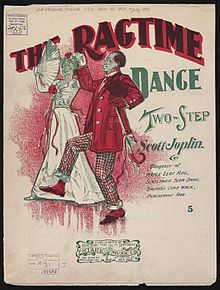The Ragtime Dance
| The Ragtime Dance | |
|---|---|
| by Scott Joplin | |
 Cover art for the 1906 sheet music | |
| Genre | Ragtime Folk Ballet |
| Form | A Stop-Time Two Step |
| Published | 1902 & 1906 |
| Publisher | John Stark & Son |
| Instrument: Piano Solo | |
"The Ragtime Dance" is a piece of ragtime music by Scott Joplin, first published in 1902.
Publication history
Although the piece was performed in Sedalia, Missouri on November 24, 1899, it wasn't published until 1902. John Stillwell Stark had planned publishing it in September 1899,[1] but had doubts about the marketability of the piece and delayed publication. When he eventually published it in 1902, at the urging of his daughter, it was a commercial failure.[2]
The 1902 arrangement was a short ragtime folk ballet suitable for stage performance, complete with narration and
Four years later, Stark republished the piece in a piano rag arrangement, stripped of its narration and choreography and substantially shortened.[2] The copyright for this arrangement was registered December 21, 1906.[3] The cover art for the 1906 sheet music featured an
Marvin Hamlisch incorporated "The Ragtime Dance" into a medley for the soundtrack of the Oscar-winning 1973 film The Sting.[4] The song also appeared in the soundtrack of the 1978 film Pretty Baby[5] and the 1980 Broadway musical revue Tintypes.[6]
Music (1906 arrangement)
The overall structure is: Intro AA BB CC D E F.[3]
It opens in the key of B-flat major, but modulates to E-flat major at the start of the "B" section.
The piece was subtitled "A Stop-Time Two Step". "Stop-time" refers to an unusual effect used in the second half of the piece. Starting with the "D" section, the pianist is instructed to "Stamp the heel of one foot heavily upon the floor" in time with the beat. Joplin reused this effect in his 1910 "Stoptime Rag".
Reception and legacy
In November 1970,
See also
References
- ^ Edward A. Berlin. "A Biography of Scott Joplin". Archived from the original on February 24, 2007. Retrieved June 16, 2009.
- ^ a b "Perfessor" Bill Edwards. "Rags and Pieces by Scott Joplin". Archived from the original on January 30, 2013. Retrieved June 16, 2009.
- ^ ISBN 0-486-25922-6.
- ^ "Mfiles: The Sting". Retrieved June 16, 2009.
- ^ "Soundtrack Collector: Pretty Baby". Retrieved June 16, 2009.
- ^ "IBDB song list: Tintypes". Retrieved June 16, 2009.
- ^ "Scott Joplin Piano Rags Nonesuch Records CD (w/bonus tracks)". Retrieved March 19, 2009.
- ^ "Nonesuch Records". Retrieved March 19, 2009.
- ^ Billboard magazine 1974, p. 61.
- ^ LA Times.
- ^ Rich 1979.
Sources
- "Entertainment Awards Database". Los Angeles Times. Retrieved March 17, 2009.
- "Best Selling Classical LPs". Billboard. September 28, 1974. p. 61. Retrieved July 29, 2011.
- Rich, Alan (December 24, 1979). "Music". New York. p. 81. Retrieved August 5, 2011.
External links
- Video of "The Ragtime Dance" being played on YouTube
